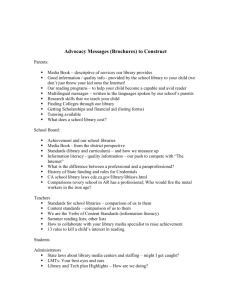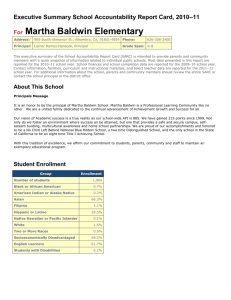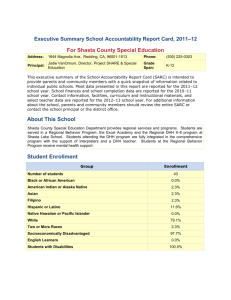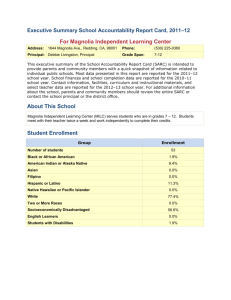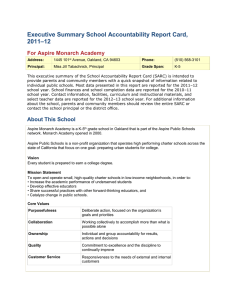0 - Alhambra Unified School District
advertisement
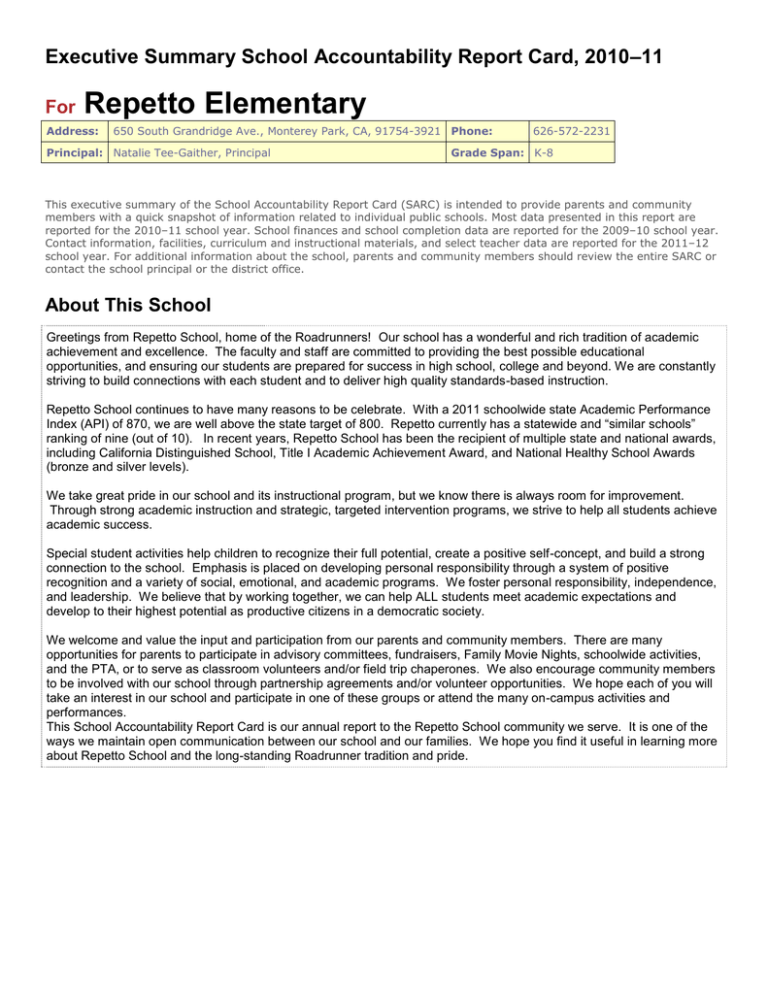
Executive Summary School Accountability Report Card, 2010–11 For Repetto Elementary Address: 650 South Grandridge Ave., Monterey Park, CA, 91754-3921 Phone: Principal: Natalie Tee-Gaither, Principal 626-572-2231 Grade Span: K-8 This executive summary of the School Accountability Report Card (SARC) is intended to provide parents and community members with a quick snapshot of information related to individual public schools. Most data presented in this report are reported for the 2010–11 school year. School finances and school completion data are reported for the 2009–10 school year. Contact information, facilities, curriculum and instructional materials, and select teacher data are reported for the 2011–12 school year. For additional information about the school, parents and community members should review the entire SARC or contact the school principal or the district office. About This School Greetings from Repetto School, home of the Roadrunners! Our school has a wonderful and rich tradition of academic achievement and excellence. The faculty and staff are committed to providing the best possible educational opportunities, and ensuring our students are prepared for success in high school, college and beyond. We are constantly striving to build connections with each student and to deliver high quality standards-based instruction. Repetto School continues to have many reasons to be celebrate. With a 2011 schoolwide state Academic Performance Index (API) of 870, we are well above the state target of 800. Repetto currently has a statewide and “similar schools” ranking of nine (out of 10). In recent years, Repetto School has been the recipient of multiple state and national awards, including California Distinguished School, Title I Academic Achievement Award, and National Healthy School Awards (bronze and silver levels). We take great pride in our school and its instructional program, but we know there is always room for improvement. Through strong academic instruction and strategic, targeted intervention programs, we strive to help all students achieve academic success. Special student activities help children to recognize their full potential, create a positive self-concept, and build a strong connection to the school. Emphasis is placed on developing personal responsibility through a system of positive recognition and a variety of social, emotional, and academic programs. We foster personal responsibility, independence, and leadership. We believe that by working together, we can help ALL students meet academic expectations and develop to their highest potential as productive citizens in a democratic society. We welcome and value the input and participation from our parents and community members. There are many opportunities for parents to participate in advisory committees, fundraisers, Family Movie Nights, schoolwide activities, and the PTA, or to serve as classroom volunteers and/or field trip chaperones. We also encourage community members to be involved with our school through partnership agreements and/or volunteer opportunities. We hope each of you will take an interest in our school and participate in one of these groups or attend the many on-campus activities and performances. This School Accountability Report Card is our annual report to the Repetto School community we serve. It is one of the ways we maintain open communication between our school and our families. We hope you find it useful in learning more about Repetto School and the long-standing Roadrunner tradition and pride. Student Enrollment Group Enrollment Number of students 758 Black or African American 0.5% American Indian or Alaska Native 0.1% Asian 53.0% Filipino 0.5% Hispanic or Latino 36.3% Native Hawaiian or Pacific Islander 0.4% White 6.5% Two or More Races 2.2% Socioeconomically Disadvantaged 55.4% English Learners 43.5% Students with Disabilities 9.1% Teachers Indicator Teachers Teachers with full credential 31 Teachers without full credential 0 Teachers Teaching Outside Subject Area of Competence 0 Misassignments of Teachers of English Learners 0 Total Teacher Misassignments 0 Student Performance Subject Students Proficient and Above on STAR* Program Results English-Language Arts 69% Mathematics 73% Science 69% History-Social Science 77% *Standardized Testing and Reporting Program assessments used for accountability purposes include the California Standards Tests, the California Modified Assessment, and the California Alternate Performance Assessment. Academic Progress* Indicator Result 2011 Growth API Score (from 2011 Growth API Report) 870 Statewide Rank (from 2010 Base API Report) Met All 2011 AYP Requirements 9 no Number of AYP Criteria Met Out of the Total Number of Criteria Possible Met 18 of 21 2011–12 Program Improvement Status (PI Year) *The Academic Performance Index is required under state law. Adequate Yearly Progress is required by federal law. School Facilities Summary of Most Recent Site Inspection The inspection on 12/2/2011 by the Director of Facilities Services found the site to be clean, safe, and in good repair with no major defects requiring emergency repairs. Repairs Needed Most repairs are general maintenance or wear and tear items. Corrective Actions Taken or Planned No major repairs or improvements are scheduled at this time. Curriculum and Instructional Materials Core Curriculum Area Pupils Who Lack Textbooks and Instructional Materials Reading/Language Arts 0% Mathematics 0% Science 0% History-Social Science 0% Foreign Language N/A Health N/A Visual and Performing Arts N/A Science Laboratory Equipment (grades 9-12) N/A School Finances Level Expenditures Per Pupil (Unrestricted Sources Only) School Site $5,158 District $5,259 State $5,455 School Completion Indicator Result Graduation Rate (if applicable) N/A Postsecondary Preparation Measure Percent Pupils Who Completed a Career Technical Education Program and Earned a High School Diploma N/A Graduates Who Completed All Courses Required for University of California or California State University Admission N/A School Accountability Report Card Reported Using Data from the 2010–11 School Year Published During 2011–12 Every school in California is required by state law to publish a School Accountability Report Card (SARC), by February 1 of each year. The SARC contains information about the condition and performance of each California public school. For more information about SARC requirements, see the California Department of Education (CDE) SARC Web page at http://www.cde.ca.gov/ta/ac/sa/. For additional information about the school, parents and community members should contact the school principal or the district office. I. Data and Access Ed-Data Partnership Web Site Ed-Data is a partnership of the CDE, EdSource, and the Fiscal Crisis and Management Assistance Team (FCMAT) that provides extensive financial, demographic, and performance information about California’s public kindergarten through grade twelve school districts and schools. DataQuest DataQuest is an online data tool located on the CDE DataQuest Web page at http://dq.cde.ca.gov/dataquest/ that contains additional information about this school and comparisons of the school to the district, the county, and the state. Specifically, DataQuest is a dynamic system that provides reports for accountability (e.g., state Academic Performance Index [API], federal Adequate Yearly Progress [AYP]), test data, enrollment, high school graduates, dropouts, course enrollments, staffing, and data regarding English learners. Internet Access Internet access is available at public libraries and other locations that are publicly accessible (e.g., the California State Library). Access to the Internet at libraries and public locations is generally provided on a first-come, first-served basis. Other use restrictions may include the hours of operation, the length of time that a workstation may be used (depending on availability), the types of software programs available on a workstation, and the ability to print documents. II. About This School Contact Information (School Year 2011–12) School District School Name Repetto Elementary District Name Alhambra Unified Street 650 South Grandridge Ave. Phone Number (626) 943-3000 City, State, Zip Monterey Park, CA, 91754-3921 Web Site www.repettok8.net Phone Number 626-572-2231 Superintendent Donna Perez Principal E-mail Address perez_donna@alhambra.k12.ca.us CDS Code 19757136011100 Natalie Tee-Gaither, Principal E-mail Address repetto@ausd.us School Description and Mission Statement (School Year 2010–11) Repetto’s school vision is for all students to meet or exceed grade level standards appropriate to their diverse needs and to prepare them for participation in society as worthwhile and productive citizens. Teachers will incorporate a variety of instructional strategies based on current research and practice. All stakeholders will contribute and provide support to ensure student success and achievement. Opportunities for Parental Involvement (School Year 2010–11) Parent and staff members participate on various committees that make decisions regarding the priorities and direction of the educational plan to ensure instructional programs are consistent with student needs and comply with District goals. These committees include: School Site Council (SSC) English Learners Advisory Council (ELAC) School Advisory Council (SAC) Parent 7th/8th Grade Promotion Committee Parent Teachers Association (PTA) SSC, ELAC and SAC meet at least six times per year to discuss accountability data, develop the Single Plan for Student Achievement, set and discuss instructional priorities, and decide how the school’s categorical budget is spent. The Alhambra Unified School District sponsors the Kindergarten through College Project that is designed to educate parents about the importance of preparing for college, starting with students in kindergarten. The program includes parent training that includes topics such as introduction to the college system, applying to college, understanding college entrance exams, financial aid opportunities, and saving for college. Our site also offers parent workshops about Developmental Assets, nutrition education, and test preparation. We are fortunate to have a community that is very supportive of Repetto School. Numerous programs and activities have been enriched by generous monetary and in-kind contributions by the following organizations: Albertson’s, Arcadia Assistance League, Carrusel Uniforms, Fresh & Easy Groceries, Golf-n-Stuff, In-n-Out Burgers, Jamba Juice, Japanese Business Association, Lions Club, Monterey Park Library, Monterey Park Police Department, Pizza Hut, Ralph’s Grocery Stores, Raytheon, Rotary Club, Shakey’s, Sizzler, Soroptomist Club, Souplantation, Target, and Wells Fargo Bank. Student Enrollment by Grade Level (School Year 2010–11) Grade Level Number of Students Grade Level Number of Students Kindergarten 73 Grade 8 Grade 1 82 Ungraded Elementary 0 Grade 2 86 Grade 9 0 Grade 3 78 Grade 10 0 Grade 4 85 Grade 11 0 Grade 5 101 Grade 12 0 Grade 6 88 Ungraded Secondary Grade 7 76 Total Enrollment 89 0 758 Student Enrollment by Subgroup (School Year 2010–11) Group Percent of Total Enrollment Black or African American 0.5% American Indian or Alaska Native 0.1% Asian 53.0% Filipino 0.5% Hispanic or Latino 36.3% Native Hawaiian or Pacific Islander 0.4% White 6.5% Two or More Races 2.2% Socioeconomically Disadvantaged 55.4% English Learners 43.5% Students with Disabilities 9.1% Average Class Size and Class Size Distribution (Elementary) Grade Level Avg. Class Size 2008–09 Number of Classes* 1-20 21-32 Avg. Class Size 33+ 2009–10 Number of Classes* 1-20 21-32 33+ Avg. Class Size 2010–11 Number of Classes* 1-20 21-32 33+ K 16.0 4 0 0 19.14 4 0 0 17.5 4 0 0 1 18.3 3 0 0 20.48 5 0 0 20.0 4 0 0 2 16.5 4 0 0 20.48 5 0 0 20.0 5 0 0 3 19.8 4 0 0 20.48 5 0 0 18.3 4 0 0 4 32.5 0 1 1 31.87 3 2 1 33.0 0 0 2 5 26.5 1 0 1 31.87 3 0 2 26.3 1 3 0 6 32.0 0 1 0 31.87 2 1 1 33.0 0 0 3 Other * Number of classes indicates how many classes fall into each size category (a range of total students per classroom). Average Class Size and Class Size Distribution (Secondary) Subject Avg. Class Size 2008–09 Number of Classes* 1-22 23-32 33+ Avg. Class Size 2009–10 Number of Classes* 1-22 23-32 33+ Avg. Class Size 2010–11 Number of Classes* 1-22 23-32 33+ English 32.6 0 3 7 27.5 2 6 4 Mathematics 27.0 2 3 1 25.7 1 3 2 Science 33.2 1 0 4 33.0 1 1 3 Social Science 33.0 0 1 4 33.0 0 2 3 * Number of classes indicates how many classrooms fall into each size category (a range of total students per classroom). At the secondary school level, this information is reported by subject area rather than grade level. III. School Climate School Safety Plan (School Year 2010–11) The Safety of students and staff is a primary concern. The school complies with laws, rules, and regulations pertaining to hazardous materials and State earthquake standards. The school’s disaster drills are conducted regularly throughout the school year. All visitors must check in at the school office and wear visitors’ badges while on school grounds. During lunch, recesses, and before and after school, yard supervisors monitor students and school grounds, including the cafeteria and playgrounds, to ensure a safe and orderly environment. The Comprehensive School Safety Plan was developed by the School Site Council in cooperation with local law enforcement in order to comply with Senate Bill 187 of 1997. The plan provides students and staff a means to ensure a safe and orderly learning environment. Components of the Comprehensive School Safety Plan include child abuse reporting procedures, teacher notification of dangerous pupils procedures, disaster response procedures, procedures for safe ingress and egress from school, sexual harassment policy, and suspension and expulsion policies. The School Site Council evaluates the plan annually and updates the plan as needed. The plan was last updated and reviewed with school staff in March 2010. An updated copy is available to the public at the school and district offices. Suspensions and Expulsions Rate* School 2008–09 School 2009–10 School 2010–11 District 2008–09 District 2009–10 District 2010–11 Suspensions 8.03% 4.29% 1.06% 8.42% 6.31% 2.35% Expulsions 0.00% 0.54% 0.13% 1.55% 1.43% 0.30% * The rate of suspensions and expulsions is calculated by dividing the total number of incidents by the total enrollment. IV. School Facilities School Facility Conditions and Planned Improvements (School Year 2011–12) Portable classrooms 29 and 30 have been replaced with portables that are newer and in better condition. The heating and air conditioning units on rooms 25 -28 are scheduled for replacement during the year. School Facility Good Repair Status (School Year 2011–12) System Inspected Repair Status Exemplary Systems: Gas Leaks, Mechanical/HVAC, Sewer Good Fair X Interior: Interior Surfaces X Cleanliness: Overall Cleanliness, Pest/ Vermin Infestation X Electrical: Electrical X Restrooms/Fountains: Restrooms, Sinks/ Fountains X Safety: Fire Safety, Hazardous Materials X Structural: Structural Damage, Roofs X External: Playground/School Grounds, Windows/ Doors/Gates/Fences X Overall Rating X Note: Cells shaded in black do not require data. Poor Repair Needed and Action Taken or Planned Some rooms need ceiling tiles changed. The office and auditorium need to be painted. V. Teachers Teacher Credentials Teachers School 2008–09 With Full Credential School 2009–10 33 31 School 2010–11 District 2010–11 31 694 Without Full Credential 1 0 0 0 Teaching Outside Subject Area of Competence (with full credential) 0 0 0 10 Teacher Misassignments and Vacant Teacher Positions Indicator 2009–10 2010–11 2011–12 Misassignments of Teachers of English Learners 0 0 0 Total Teacher Misassignments* 0 0 0 Vacant Teacher Positions 1 16 18 Note: “Misassignments” refers to the number of positions filled by teachers who lack legal authorization to teach that grade level, subject area, student group, etc. * Total Teacher Misassignments includes the number of Misassignments of Teachers of English Learners. Core Academic Classes Taught by Highly Qualified Teachers (School Year 2010–11) The Federal Elementary and Secondary Education Act (ESEA), also known as No Child Left Behind (NCLB), requires that core academic subjects be taught by Highly Qualified Teachers, defined as having at least a bachelor’s degree, an appropriate California teaching credential, and demonstrated core academic subject area competence. For more information, see the CDE Improving Teacher and Principal Quality Web page at: http://www.cde.ca.gov/nclb/sr/tq/ Location of Classes Percent of Classes In Core Academic Subjects Taught by Highly Qualified Teachers Percent of Classes In Core Academic Subjects Not Taught by Highly Qualified Teachers This School 100.00% 0.00% All Schools in District 99.31% 0.69% High-Poverty Schools in District 99.31% 0.69% Low-Poverty Schools in District 100.00% 0.00% Note: High-poverty schools are defined as those schools with student eligibility of approximately 40 percent or more in the free and reduced price meals program. Low-poverty schools are those with student eligibility of approximately 25 percent or less in the free and reduced price meals program. VI. Support Staff Academic Counselors and Other Support Staff (School Year 2010–11) Title Number of FTE* Assigned to School Academic Counselor 0 Counselor (Social/Behavioral or Career Development) 0 Library Media Teacher (librarian) 0 Library Media Services Staff (paraprofessional) 0 Psychologist 0.5 Social Worker 0 Nurse 0.5 Speech/Language/Hearing Specialist 1 Resource Specialist (non-teaching) 1 Other 2 Average Number of Students per Academic Counselor N/A Note: Cells shaded in black do not require data. * One Full-Time Equivalent (FTE) equals one staff member working full-time; one FTE could also represent two staff members who each work 50 percent of full-time. VII. Curriculum and Instructional Materials Quality, Currency, Availability of Textbooks and Instructional Materials (School Year 2011–12) This section describes whether the textbooks and instructional materials used at the school are from the most recent adoption; whether there are sufficient textbooks and instruction materials for each student; and information about the school’s use of any supplemental curriculum or non-adopted textbooks or instructional materials. Year and month in which data were collected: December 2011 Core Curriculum Area Textbooks and instructional materials/year of adoption From most recent adoption? Percent students lacking own assigned copy Reading/Language Arts K-5: Houghton Mifflin, 2009 6-8: McDougal Littell, 2002 Yes 0% Mathematics K-5: Harcourt School Publishers, 2008 6-8: McDougal Littell, 2008 Yes 0% Science K-5: MacMilian/McGraw-Hill, 2007 6-8: Prentice Hall, 2007 Yes 0% History-Social Science K-5: Harcourt Brace, 2006 6-8: Glencoe, 2006 Yes 0% Foreign Language N/A N/A 0% Health N/A N/A 0% Visual and Performing Arts N/A N/A 0% Science Laboratory Equipment (grades 9-12) N/A N/A 0% VIII. School Finances Expenditures Per Pupil and School Site Teacher Salaries (Fiscal Year 2009–10) Level Total Expenditures Per Pupil Expenditures Per Pupil (Supplemental / Restricted) Expenditures Per Pupil (Basic / Unrestricted) Average Teacher Salary $6,415 $1,257 $5,158 $70,160 District $5,259 $70,053 Percent Difference – School Site and District -1.92% 0.15% State $5,455 $67,667 Percent Difference – School Site and State -5.44% 3.68% School Site Note: Cells shaded in black do not require data. Supplemental/Restricted expenditures come from money whose use is controlled by law or by a donor. Money that is designated for specific purposes by the district or governing board is not considered restricted. Basic/unrestricted expenditures are from money whose use, except for general guidelines, is not controlled by law or by a donor. For detailed information on school expenditures for all districts in California, see the CDE Current Expense of Education & Per-pupil Spending Web page at http://www.cde.ca.gov/ds/fd/ec/. For information on teacher salaries for all districts in California, see the CDE Certificated Salaries & Benefits Web page at http://www.cde.ca.gov/ds/fd/cs/. To look up expenditures and salaries for a specific school district, see the Ed-Data Web site at: http://www.ed-data.org. Types of Services Funded (Fiscal Year 2010–11) This section provides information about the programs and supplemental services that are available at the school and funded through either categorical or other sources. In addition to general State funding, Alhambra Unified School District receives State and Federal categorical funding for special programs. For the 2010-11 school year, the District received approximately $1,688 per student in Federal or State aid for the following categorical, special education, and support programs: Title I Title II Title III Title IV WIA Migrant Education Lottery Instructional Materials Special Education EIA/SCE EIA/LEP VAPA Teacher and Administrative Salaries (Fiscal Year 2009–10) Category District Amount State Average For Districts In Same Category Beginning Teacher Salary $35,430 $41,035 Mid-Range Teacher Salary $66,490 $65,412 Highest Teacher Salary $97,260 $84,837 $123,067 $106,217 $0 $111,763 Average Principal Salary (High) $138,132 $121,538 Superintendent Salary $207,289 $197,275 35.00% 39.00% 5.00% 5.00% Average Principal Salary (Elementary) Average Principal Salary (Middle) Percent of Budget for Teacher Salaries Percent of Budget for Administrative Salaries Note: For detailed information on salaries, see the CDE Certificated Salaries & Benefits Web page at http://www.cde.ca.gov/ds/fd/cs/. IX. Student Performance Standardized Testing and Reporting Program The Standardized Testing and Reporting (STAR) Program consists of several key components, including: California Standards Tests (CSTs), which include English-language arts (ELA) and mathematics in grades two through eleven; science in grades five, eight, and nine through eleven; and history-social science in grades eight, and nine through eleven. California Modified Assessment (CMA), an alternate assessment that is based on modified achievement standards in ELA for grades three through eleven; mathematics for grades three through seven, Algebra I, and Geometry; and science in grades five and eight, and Life Science in grade ten. The CMA is designed to assess those students whose disabilities preclude them from achieving grade-level proficiency on an assessment of the California content standards with or without accommodations. California Alternate Performance Assessment (CAPA), includes ELA and mathematics in grades two through eleven, and science for grades five, eight, and ten. The CAPA is given to those students with significant cognitive disabilities whose disabilities prevent them from taking either the CSTs with accommodations or modifications or the CMA with accommodations. The assessments under the STAR Program show how well students are doing in relation to the state content standards. On each of these assessments, student scores are reported as performance levels. For detailed information regarding the STAR Program results for each grade and performance level, including the percent of students not tested, see the CDE STAR Results Web site at http://star.cde.ca.gov. Standardized Testing and Reporting Results for All Students – Three-Year Comparison Subject Percent of Students Scoring at Proficient or Advanced (meeting or exceeding the state standards) School 2008– 09 District 2009– 10 2010– 11 2008– 09 State 2009– 10 2010– 11 2008– 09 2009– 10 2010– 11 English-Language Arts 70% 70% 69% 56% 59% 61% 49% 52% 54% Mathematics 77% 75% 73% 59% 61% 64% 46% 48% 50% Science 68% 81% 69% 56% 58% 63% 50% 54% 57% History-Social Science 68% 78% 77% 47% 48% 52% 41% 44% 48% Note: Scores are not shown when the number of students tested is ten or less, either because the number of students in this category is too small for statistical accuracy or to protect student privacy. Standardized Testing and Reporting Results by Student Group – Most Recent Year Group Percent of Students Scoring at Proficient or Advanced English- Language Arts Mathematics Science History- Social Science All Students in the LEA 61% 64% 63% 52% All Students at the School 69% 73% 69% 77% Male 65% 70% 68% 73% Female 74% 75% 70% 81% Black or African American 0% 0% 0% 0% American Indian or Alaska Native 0% 0% 0% 0% 77% 86% 79% 77% 0% 0% 0% 0% 57% 56% 55% 76% 0% 0% 0% 0% 76% 62% 73% 0% 0% 0% 0% 0% Socioeconomically Disadvantaged 60% 66% 58% 74% English Learners 59% 73% 49% 36% Students with Disabilities 43% 49% 0% 0% 0% 0% 0% 0% Asian Filipino Hispanic or Latino Native Hawaiian or Pacific Islander White Two or More Races Students Receiving Migrant Education Services Note: Scores are not shown when the number of students tested is ten or less, either because the number of students in this category is too small for statistical accuracy or to protect student privacy. California High School Exit Examination The California High School Exit Examination (CAHSEE) is primarily used as a graduation requirement. However, the grade ten results of this exam are also used to establish the percentages of students at three proficiency levels (not proficient, proficient, or advanced) in ELA and mathematics to compute AYP designations required by the federal ESEA, also known as NCLB. For detailed information regarding CAHSEE results, see the CDE CAHSEE Web site at http://cahsee.cde.ca.gov/. California High School Exit Examination Results for All Grade Ten Students – Three-Year Comparison (if applicable) Subject Percent of Students Scoring at Proficient or Advanced School 2008– 09 District 2009– 10 2010– 11 2008– 09 State 2009– 10 2010– 11 2008– 09 2009– 10 2010– 11 English-Language Arts Mathematics Note: Scores are not shown when the number of students tested is ten or less, either because the number of students in this category is too small for statistical accuracy or to protect student privacy. California High School Exit Examination Grade Ten Results by Student Group – Most Recent Year (if applicable) Group English-Language Arts Not Proficient Mathematics Proficient Advanced Not Proficient Proficient Advanced All Students in the LEA All Students at the School Male Female Black or African American American Indian or Alaska Native Asian Filipino Hispanic or Latino Native Hawaiian or Pacific Islander White Two or More Races Socioeconomically Disadvantaged English Learners Students with Disabilities Students Receiving Migrant Education Services Note: Scores are not shown when the number of students tested is ten or less, either because the number of students in this category is too small for statistical accuracy or to protect student privacy. California Physical Fitness Test Results (School Year 2010–11) The California Physical Fitness Test (PFT) is administered to students in grades five, seven, and nine only. This table displays by grade level the percent of students meeting the fitness standards for the most recent testing period. For detailed information regarding this test, and comparisons of a school’s test results to the district and state, see the CDE PFT Web page at http://www.cde.ca.gov/ta/tg/pf/. Grade Level Percent of Students Meeting Fitness Standards Four of Six Standards Five of Six Standards Six of Six Standards 5 22.50% 21.60% 40.20% 7 10.71% 20.00% 65.30% 9 0.00% 0.00% 0.00% Note: Scores are not shown when the number of students tested is ten or less, either because the number of students in this category is too small for statistical accuracy or to protect student privacy. X. Accountability Academic Performance Index The Academic Performance Index (API) is an annual measure of state academic performance and progress of schools in California. API scores range from 200 to 1,000, with a statewide target of 800. For detailed information about the API, see the CDE API Web page at http://www.cde.ca.gov/ta/ac/ap/. Academic Performance Index Ranks – Three-Year Comparison This table displays the school’s statewide and similar schools’ API ranks. The statewide API rank ranges from 1 to 10. A statewide rank of 1 means that the school has an API score in the lowest ten percent of all schools in the state, while a statewide rank of 10 means that the school has an API score in the highest ten percent of all schools in the state. The similar schools API rank reflects how a school compares to 100 statistically matched “similar schools.” A similar schools rank of 1 means that the school’s academic performance is comparable to the lowest performing ten schools of the 100 similar schools, while a similar schools rank of 10 means that the school’s academic performance is better than at least 90 of the 100 similar schools. API Rank 2008 2009 2010 Statewide 8 9 9 Similar Schools 9 8 9 Academic Performance Index Growth by Student Group – Three-Year Comparison Group Actual API Change 2008–09 All Students at the School Actual API Change 2009–10 Actual API Change 2010–11 25 11 -13 23 23 -4 24 9 -23 Socioeconomically Disadvantaged 20 10 -15 English Learners 37 16 10 Black or African American American Indian or Alaska Native Asian Filipino Hispanic or Latino Native Hawaiian or Pacific Islander White Two or More Races N/D Students with Disabilities Note: “N/D” means that no data were available to the CDE or LEA to report. “B” means the school did not have a valid API Base and there is no Growth or target information. “C” means the school had significant demographic changes and there is no Growth or target information. Academic Performance Index Growth by Student Group – 2011 Growth API Comparison This table displays, by student group, the number of students included in the API and the 2011 Growth API at the school, LEA, and state level. Group 2011 Growth API Number of Students School All Students at the School 582 Black or African American American Indian or Alaska Native Asian Filipino Native Hawaiian or Pacific Islander White State 4,683,676 778 4 96 784 317,856 696 1 18 757 33,774 733 6,910 894 398,869 898 205 878 123,245 859 5,687 739 2,406,749 729 16 810 26,953 764 452 828 1,258,831 845 131 909 76,766 836 212 928 796 3 44 Two or More Races Number of Students 828 3 Hispanic or Latino LEA 13,537 306 870 Number of Students 849 9 Socioeconomically Disadvantaged 324 833 9,660 808 2,731,843 726 English Learners 247 890 6,342 818 1,521,844 707 60 669 1,265 608 521,815 595 Students with Disabilities Adequate Yearly Progress The federal ESEA requires that all schools and districts meet the following Adequate Yearly Progress (AYP) criteria: Participation rate on the state’s standards-based assessments in ELA and mathematics Percent proficient on the state’s standards-based assessments in ELA and mathematics API as an additional indicator Graduation rate (for secondary schools) For detailed information about AYP, including participation rates and percent proficient results by student group, see the CDE AYP Web page at http://www.cde.ca.gov/ta/ac/ay/. Adequate Yearly Progress Overall and by Criteria (School Year 2010–11) AYP Criteria School District Made AYP Overall No No Met Participation Rate - English-Language Arts Yes Yes Met Participation Rate - Mathematics Yes Yes Met Percent Proficient - English-Language Arts No No Met Percent Proficient - Mathematics No No Met API Criteria Yes Yes Met Graduation Rate N/A Yes Federal Intervention Program (School Year 2011–12) Schools and districts receiving federal Title I funding enter Program Improvement (PI) if they do not make AYP for two consecutive years in the same content area (ELA or mathematics) or on the same indicator (API or graduation rate). After entering PI, schools and districts advance to the next level of intervention with each additional year that they do not make AYP. For detailed information about PI identification, see the CDE PI Status Determinations Web page: http://www.cde.ca.gov/ta/ac/ay/tidetermine.asp. Indicator Program Improvement Status School District Not in PI In PI First Year of Program Improvement 2008-2009 Year in Program Improvement Year 3 Number of Schools Currently in Program Improvement 7 Percent of Schools Currently in Program Improvement 38.9% Note: Cells shaded in black do not require data. XI. School Completion and Postsecondary Preparation Admission Requirements for California’s Public Universities University of California Admission requirements for the University of California (UC) follow guidelines set forth in the Master Plan, which requires that the top one-eighth of the state’s high school graduates, as well as those transfer students who have successfully completed specified college course work, be eligible for admission to the UC. These requirements are designed to ensure that all eligible students are adequately prepared for University-level work. For general admissions requirements, please visit the UC Admissions Information Web page at http://www.universityofcalifornia.edu/admissions/. (Outside source) California State University Eligibility for admission to the California State University (CSU) is determined by three factors: Specific high school courses Grades in specified courses and test scores Graduation from high school Some campuses have higher standards for particular majors or students who live outside the local campus area. Because of the number of students who apply, a few campuses have higher standards (supplementary admission criteria) for all applicants. Most CSU campuses have local admission guarantee policies for students who graduate or transfer from high schools and colleges that are historically served by a CSU campus in that region. For admission, application, and fee information see the CSU Web page at http://www.calstate.edu/admission/admission.shtml. (Outside source) Dropout Rate and Graduation Rate Indicator School 2007– 08 Dropout Rate (1year) Graduation Rate 0.0 District 2008– 09 0.0 2009– 10 0.0 2007– 08 State 2008– 09 2009– 10 2007– 08 2008– 09 2009– 10 2.8 2.9 1.4 4.9 5.7 4.6 87.39 87.30 92.89 80.21 78.59 80.44 Note: The National Center for Education Statistics graduation rate as reported in AYP is provided in this table. Completion of High School Graduation Requirements This table displays, by student group, the percent of students who began the 2010–11 school year in grade twelve and were a part of the school’s most recent graduating class, meeting all state and local graduation requirements for grade twelve completion, including having passed both the ELA and mathematics portions of the CAHSEE or received a local waiver or state exemption. Group Graduating Class of 2011 School District State All Students N/D Black or African American N/D American Indian or Alaska Native N/D Asian N/D Filipino N/D Hispanic or Latino N/D Native Hawaiian or Pacific Islander N/D White N/D Two or More Races N/D Socioeconomically Disadvantaged N/D English Learners N/D Students with Disabilities N/D Note: “N/D” means that no data were available to the CDE or LEA to report. Career Technical Education Participation (School Year 2010–11) Measure CTE Program Participation Number of pupils participating in CTE Percent of pupils completing a CTE program and earning a high school diploma Percent of CTE courses sequenced or articulated between the school and institutions of postsecondary education Courses for University of California and/or California State University Admission UC/CSU Course Measure Percent 2010-11 Students Enrolled in Courses Required for UC/CSU Admission 7.8% 2009-10 Graduates Who Completed All Courses Required for UC/CSU Admission 0.0% Advanced Placement Courses (School Year 2010–11) Subject Number of AP Courses Offered* Percent of Students In AP Courses Computer Science English Fine and Performing Arts Foreign Language Mathematics Science Social Science All courses Note: Cells shaded in black do not require data. *Where there are student course enrollments. XII. Instructional Planning and Scheduling Professional Development This section provides information on the annual number of school days dedicated to staff development for the most recent three-year period. Every school in the Alhambra Unified School District has always been and continues to be committed to improvement in student learning. Teachers are actively participating in standards-based professional development, assessment and strategies to help all students meet state standards. Alhambra Unified School District offers staff development opportunities to teachers, administrators, and instructional aides. Staff members build teaching skills and concepts through participation in conferences, workshops and collaboration meetings throughout the year. The District offers three staff development days where teachers participated in a broad-based variety of professional growth sessions in standards-based curriculum and instructional strategies. The District’s Professional Development Committee, consisting of administrators and teachers, meets to plan and develop the staff development for the District. Using student achievement data and results from surveys, the Committee identifies training opportunities that are aligned with the goals of the District and that will improve the learning of all students. Throughout the school year, professional development on district initiatives is provided to teachers through the use of substitutes. This includes: Thinking Maps, GATE Level II & III training, technology, problem solving. The Alhambra Unified School District offers several programs to support new and veteran teachers in their classroom skills and to ensure continued professional development. Beginning Teacher Support and Assessment (BTSA) Induction provides new teachers with assistance and support over a two-year period. The District’s Peer Assistance and Review (PAR) program is designed to assist both veteran and new teachers by providing in-class support.
